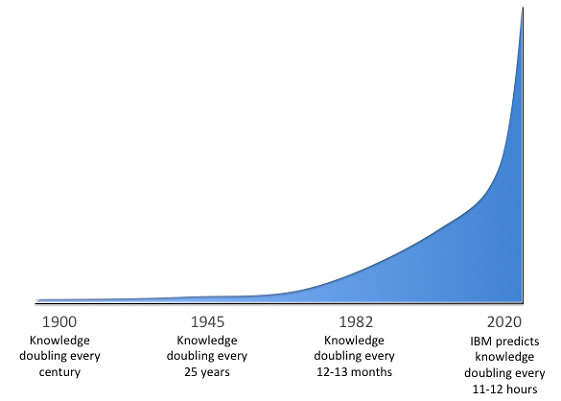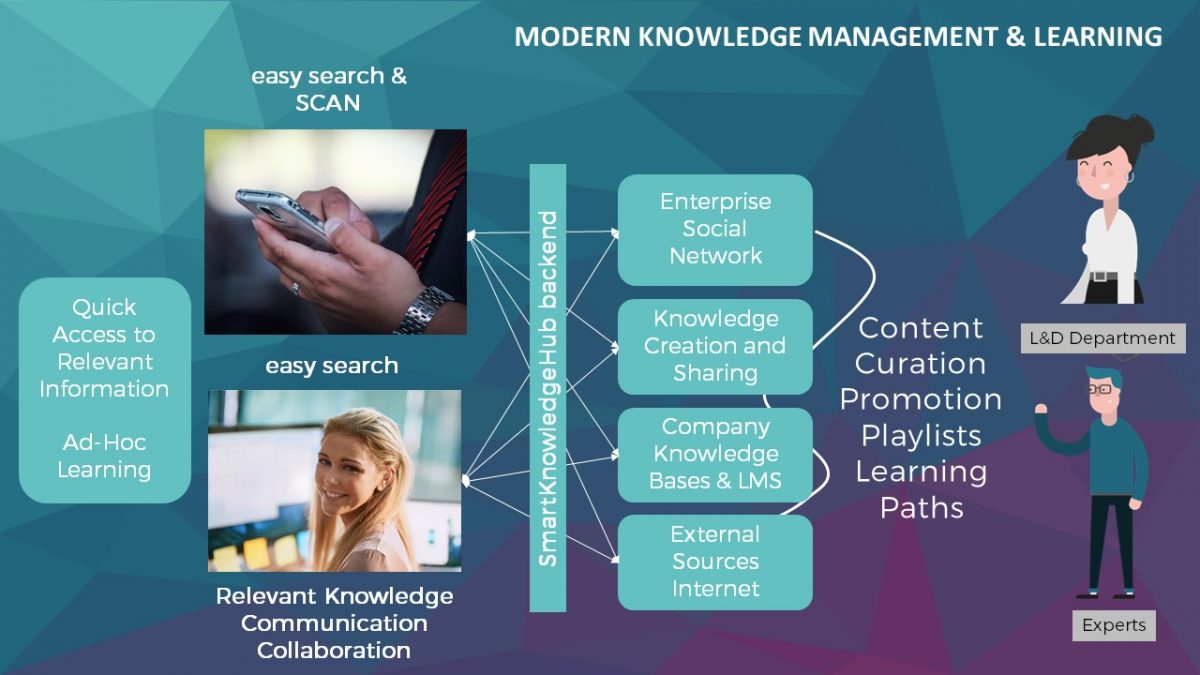Learning is good. Knowledge is better.
It may seem simplistic at first, but in these challenging times it becomes all the more apparent. Many companies are now confronted with the following challenges to secure their futures and the futures of their employees.
- A more frequent home office which makes the organization more decentralized.
- As a result, knowledge and competencies are geographically distributed and less accessible.
- Digitalization means a change in the way we communicate, think and work.

Why learning on it’s own is no longer sufficient?
Admittedly – it is of course not possible without learning and professional training. Before a profession can be practiced, basic technical prerequisites must be created. Especially professions such as doctors or engineers for whom a large proportion of routine work cannot get around formal learning.
But what about the work and professions that are constantly evolving. Installers, field service, and maintenance personnel, for example, must constantly be able to understand and implement new systems, changing products, equipment, technologies, compliance, safety, and corresponding processes. To train these employees, again and again, i. e. with a trainer, is not only costly but can no longer keep pace with technological change. Conventional training such as classroom and eLearning has very little retention and very poor ROI.
And what about the “office workers”. According to studies, the share of work here that is “non-routine” is now more than 80% of working time.
And if something is not routine, how can you learn it? Then there is the flood of information that has arisen since the introduction of IT and the Internet and today as a result of modern digitization.
Available knowledge has doubled every 13 months since 1982. IBM estimates that this will double every 12-13 hours in 2020.
Well, the year 2020 is not yet over, so it remains only a guess. However, my personal assessment is similar.

Learning or retrieving knowledge?
You may be familiar with the statement made by “older people” about today’s youth, who reach for their cell phones every time they talk about something:
“They’re not learning properly at all anymore. They only learn where it is or where they find it!“
Now the question arises whether this is so wrong? Can you still recall important facts that you learned at school what you needed to pass a school test, which you still have to use today? I can think of very little except what I have learned from social “togetherness”. Do you?
Every day we use search engines like Google to find certain information. according to leading technology research, there is an average of 3.45 billion search queries a day (as of 2018). However, and this is interesting for today’s article “86 percent only look at the 1st Google results page”. How often have you found exactly what you were looking for on the first page or without much effort? All this creates clutter that workers need to sift through to find the knowledge that really matters, at the very moment that they need it. If, like in the case of Google, people quickly get frustrated and click away, leaving valuable information unused and neglected.
Inaccessible knowledge costs companies a lot of money
According to a report by McKinsey, employees, especially in the area of “knowledge work” (office workers) spend about 20% of their working time searching for and collecting information! McKinsey also confirms in a study the high search effort of knowledge workers. Imagine the value of 20% of employee salaries and costs, that’s one working day per week per employee, wasted, causing them frustration and demotivation, and slowing-down your company’s pace of progress without the right knowledge, when they need, where they need it, so they perform to a high standard as quickly as possible.
A medium-sized company, say with 1,000 employees, can cost $ 752,000 to search and find information.
Of course, the decisive factor is how many employees actually perform routine work and thus waste less/no working time on searching and finding information. On the other hand, the average wage for “office workers” is usually higher than the average. I currently have no statistics available on the distribution “production vs. office workers”. Better said, I couldn’t find any with a reasonable amount of time where we would be back on the topic.
But let’s assume that in the American SME sector, as with some of our customers, the proportion of employees in administration, sales, service and management – in other words, everywhere where routine is not very common – is 30%. What does it mean if one only considers the search time of these 300 employees. A lower, but still significant amount of money is spent for searching = $ 225,780.
Reducing this total search time of 300 employees by half down to 10% means that $ 112,890 worth of work is freed up per month to improve performance.

What does modern knowledge management mean?
The top priority should be to reduce the effort for searching and applying knowledge. Knowledge is often available in companies, the challenge is that knowledge resides in different information silos; e.g.
- the classical file storage,
- a learning management system (if available) or
- in the best case in a well organized intranet,
- in collaborative systems such as Microsoft Teams or other corporate social networks,
- sometimes in other Wikis or so-called knowledge databases,
- but often also in external sources.
The list alone shows the problem associated with this:
Knowledge lies everywhere, but is rarely available when you need it (“in the moment of need”).
Both classic learning systems and the so-called “Enterprise Search Systems” have hardly proven themselves and are not suitable for American medium-sized companies due to the associated costs and internal effort. Collaborative systems such as Microsoft Teams, SharePoint filing or other enterprise social networks have shown that “knowledge can also be shared digitally”. However, this is only one part of the solution.
What are the success parameters for effective and resource-saving knowledge management?
Simply put:
“An in-house Google that makes knowledge available to employees directly at the workplace in a simple, fast and relevant way, thus also supporting ad hoc learning”.
This knowledge management should at least meet the following requirements:
- Existing content must be easily and quickly integrated – ideally automatically.
- Relevant knowledge is made available to employees through smart indexing (titles, texts, tags, metadata; ideally everything is group- or profile-specific) in such a way that the knowledge is displayed in a targeted manner.
- Content from the various sources is integrated in a clear and easy-to-use mask or integrated into daily operational systems (CRM, ERP, Digital Workplace etc.), found and displayed or played back in this user interface (no system change)
A personal conclusion
From my experience, many decision-makers in American medium-sized businesses in these challenging times are thinking about how to optimize existing resources and processes to save costs. At the same time, keeping sales high or increasing them again is also a goal. Often IT or operations management is entrusted with finding out what is possible. Supply chains, sales channels or sales opportunities are analyzed to make better use of existing resources. Interestingly, the analysis is often limited to technology and processes. In doing so, one of the most important resources in the company is disregarded – namely the knowledge and the people in the company.
To ensure long-term success, company and employee knowledge should be used optimally and employees should be sufficiently involved in the process of digitization.
Um den langfristigen Erfolg zu sichern, sollten Firmen- und Mitarbeiterwissen optimal genutzt und die Mitarbeiter im Zuge der Digitalisierung ausreichend einbezogen werden.
Christian Müller, Chief Customer Success Officer bei Pokeshot
Would you now like to use your own knowledge management more effectively, but don’t know how? We would be happy to support you!
We can cover all the above parameters with our smart knowledge management solutions at Pokeshot. Do you have any questions or would you like to make an appointment for an expert dialog? Please feel free to contact us.

About the author

Christian Mueller, Chief Customer Success Officer of Pokeshot GmbH, has expertise and many years of experience in consulting medium-sized companies in the effective use of modern learning methods to increase the competence and motivation of their employees. He is a respected blogger and founder of “The Learning JEDI” LinkedIn group, where he shares his experiences with other learning experts. His expertise ranges from classic eLearning formats, game based learning to modern methods, which are characterized by the increasing demand for mutual learning (social learning) and learning by experience (performance learning).
Connect with us on facebook | twitter | LinkedIn | YouTube – that way you stay informed!